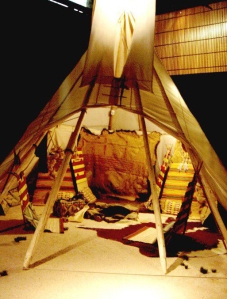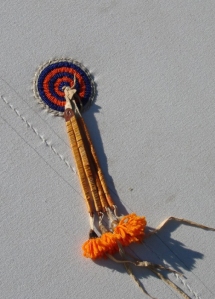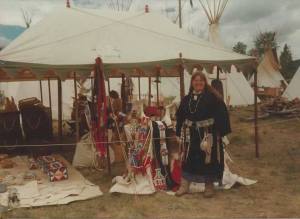A DIFFERENT KIND OF HOME
AUTHENTIC LODGINGS ON THE PLAINS
March 2014
This month’s topic isn’t so much about living in the past as it is about making sure the past is accurately represented. When I started joining various groups online, I stumbled across a group devoted to constructing tipis, the traditional home/lodge of the plains Indian tribes.
When I say devoted, I mean it. One subject matter expert is Linda Holley. She has a website dedicated to all things “tipi” (www.tipis.org), and has been researching, writing about, and constructing tipis for over 40 years!
Although the materials most of us associate with tipis (buffalo hides, elk and deer skins) are still in use, Linda says there has been a gradual transition since the 1840s to using cloth and canvas materials. Linda is the author of a book on the subject: Tipis, Tepees, Teepees: History and Design of the Cloth Tipi (available at Amazon.com).

Interior of Linda Holley’s tipi which was on display at the Schiele Museum in Gastonia NC in 2009-2010
Linda calls herself a “stitch counter.” She says that’s a person “who wants it as accurate as possible, even to hand-sewing the cloths to the stitch count.” Her interest in tipis, which began with watching television westerns and movies, became serious with the purchase of her own tipi in 1973.
She developed her webpage to set the record straight between what is a historical tipi and what is “a modern, fanciful version.” While some of these more modern versions can be works of art and fascinating in many ways, they are not recreations of historical tipis. Tipis with full, fitted linings and rain covers, or solar heating systems, generators, etc., might be fun and artfully done, but they are not examples of authentic tipis in which the plains tribes lived.

Attached to a friend’s tipi, the rosette is a representation of the Cheyenne Women’s Sewing Society group. “If you can make the rosettes’. beaded back panel, pillows, tipis, and other accoutrements, you then are a member of the society,” Linda says.
According to Linda, most of the people involved in tipi construction, groups and organizations, are not Native American, nor are they reenactors. She says very few people dress in period attire or engage in living history. However, there will be a tipi encampment at the National Pow Wow being held in July in Danville, Indiana. The encampment will have a contest, judging the tipis according to the following criteria (according to their webpage):
The primary emphasis will be on how well the tipi is pitched and furnished according to (self-identified) era and tribe of the owner:
1. Tipi Pitching
2. Outside Tipi Decoration, streamers, beadwork, quillwork, etc
3. Outside Encampment Area of Tipi, cooking area, shade areas, etc
4. Interior Decorations, furniture, containers, wood storage, etc.
Linda will be at the National Pow Wow with one of the over 300 tipis she has completed to date. She’s not judging and she’s not entering the competition, but she and the wealth of knowledge she carries around with her will be there. If you go, look for her.
Welcome to WordPress.com. After you read this, you should delete and write your own post, with a new title above. Or hit Add New on the left (of the admin dashboard) to start a fresh post.
Here are some suggestions for your first post.
- You can find new ideas for what to blog about by reading the Daily Post.
- Add PressThis to your browser. It creates a new blog post for you about any interesting page you read on the web.
- Make some changes to this page, and then hit preview on the right. You can always preview any post or edit it before you share it to the world.
